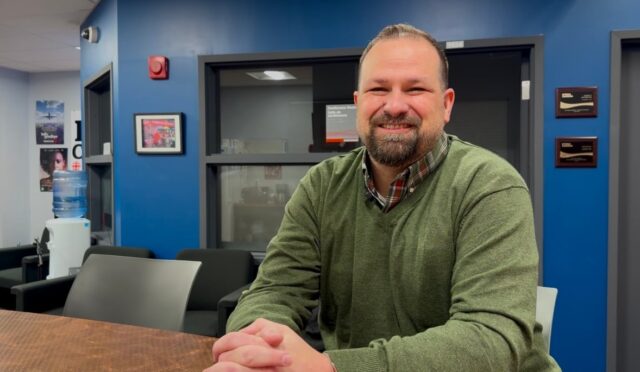Researchers at the University of Waterloo say they have made a breakthrough by introducing a new characteristic to bacteria found in wastewater, giving them the ability to break down microplastics.
The project’s principal investigator, Marc Aucoin, a professor in the Ontario school’s chemical engineering department, said bacteria already exist in water systems to clean up microplastics, adding that they are “biorobots that can be programmed to do the job.” .
“What we want to do is use a pure tool, (proteins) to be able to degrade plastics,” Aucoin said on the CBC program Okay-W. The morning edition.
The study “Degradation of polyethylene terephthalate (PET) plastics by conjugation engineered wastewater bacteria,” was published in the American journal Microbial Biotechnology.
Researchers use a pure process called “bacterial sex,” by which bacteria share genetic materials with each other when they multiply.
“(We’re) designing an organism to carry a transferable piece of DNA so that (the bacteria in wastewater) we can all produce that tool to degrade plastic.”
At this time, the degradation of microplastics in wastewater treatment plants is a safer application.– Aaron Yip, PhD candidate at the University of Waterloo
The engineered bacteria are capable of biodegrading polyethylene terephthalate (PET), a common plastic found in carpets, clothing, and food and beverage containers, the researchers say.
“In our lab, we have shown that that protein itself can help degrade a plastic sample by 50 percent in about four days,” Aucoin said.
What are microplastics?
Most plastics are not recycled and last for decades. When something made of plastic breaks down, it breaks up into small pieces known as microplastics that can contaminate and accumulate in the environment and leaching chemicals. Scientists classify degraded plastic waste products by size. Microplastics are tiny particles less than five millimeters in diameter, or about size of a sesame seed.
Sources of microplastics range from microbeads used in cosmetic and personal care products to lentil-sized plastic pellets, also known as knuckles.
In a study published in March 2024 New England Journal of Medicineresearchers who use special microscopy techniques found microplastic and nanoplastic chemicals in the plaque that lines human arteries.
In the observational study of more than 250 patients being tested for carotid artery disease, finding polyethylene in their plaque was associated with heart problems compared to those who had no plastic detected. This type of study cannot show whether small plastics caused heart problems, but it did indicate associations.
According to Aucoin, microplastics in water also increase the spread of antibiotic resistance, “so this advance could address that concern as well.”
There is still “more work to do”
Researchers are not yet at the stage of releasing the engineered bacteria into a broader environment, Aucoin said.
“There is more work to do to make this much more effective, but eventually the breakdown product will essentially be like a sugar for the body to eat,” he said.
While researchers will start with wastewater facilities, they also hope to find ways to clean up the plastic waste that accumulates in the oceans.
“We will evaluate the risks of using engineered plastic-eating bacteria in the natural environment,” said Aaron Yip, a doctoral candidate in the department of chemical engineering at the University of Waterloo.
“At this time, the degradation of microplastics in wastewater treatment plants is a safer application. “Many of these facilities are already designed to neutralize bacteria in wastewater, which would kill any engineered micro-organisms before discharging the water back into the environment.”
“There is no quick fix” for microplastics
Karen Wirsig, director of the plastics program at Environmental Defense, an advocacy organization, said it’s too early to get too excited about the research.
“My first reaction is that it is a kind of chimera… Scientific research is very important, but when we pretend that advances in a laboratory are going to solve a plastic pollution crisis on the scale that we know it exists, it is wishful thinking,” he told CBC Information.
“There are probably all kinds of interesting things that scientists can discover about how microbes can dissolve or remove microplastics from certain environments. (but)I will definitely be watching this.”

Wirsig said the researchers’ news is “interesting” regarding a sewage and wastewater treatment method, which she says is full of microplastics.
“Basically, the concern is that when we see solutions or things like this that could be presented as solutions, it’s actually too late once microplastics are in the environment,” Wirsig said.
“It’s really a shame, and trying to treat or manage them in the environment is never going to be easy and there won’t be a quick fix for that.”
Wirsig said the priority should be how to reduce the amount of plastic being manufactured, adding that the issue of microplastics is a major environmental and health concern.
“Scientists and medical professionals find microplastics wherever they look for them: in the highest mountain peaks and the deepest ocean trenches, in the Arctic ice, everywhere in the body.”
Wirsig said the biggest threat microplastics pose to the environment is probably the small organisms that mistake them for food.
“These microplastics can accumulate in our food webs because as smaller organisms are eaten by larger organisms, we are basically concentrating these contaminants more and more in our food webs,” Wirsig said.
“That’s one of the ways they probably enter the human body: through the things we eat, because they’re also in the soil, they’ve been found in plants and vegetables that people eat, in fruits.
“But one of the biggest concerns is fish, so people who rely on fish in their diet are rightly concerned about the amount of microplastics found in these species.”




